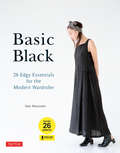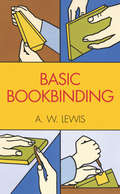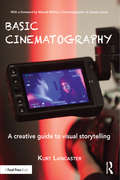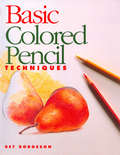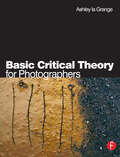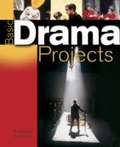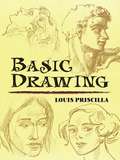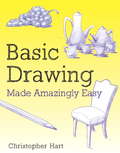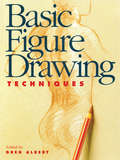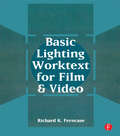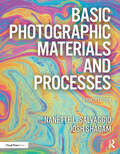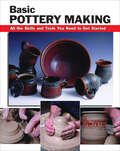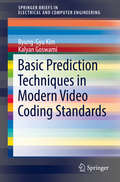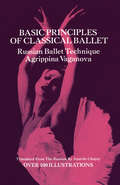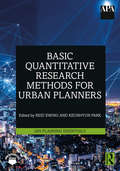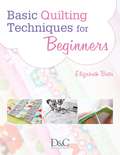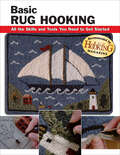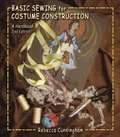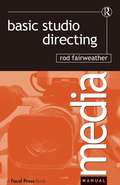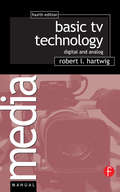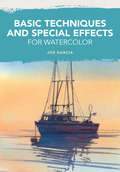- Table View
- List View
Basic Black
by Sato WatanabeBasic Black is the English edition of a classic Japanese sewing book which provides Western-sized patterns for 26 basic garments, along with detailed, easy-to-follow diagrams and instructions. All of the styles are easily customized to create your own personal style, and there is truly something for everyone and every occasion in this book-from a smart two-texture combo dress to a relaxed, bohemian tunic-and everything in-between. All the styles are thoroughly modern and practical, ranging from softly feminine or straight-line simple to smartly-tailored or loosely-deconstructed. Designs in this book are ones that you'll come back to again and again. Author Sato Watanabe has published many books that are favorites among Japanese sewing fans. In this book she shows you how to make truly professional-quality pieces easily and inexpensively at home. She studied clothing and accessory design at Tokyo's famous Bunka Fashion College before beginning a career as a magazine editor, eventually turning her writing skills to books.
Basic Black
by Sato WatanabeSew chic, dark-toned clothes with this stylish Japanese sewing book and add a touch of originality to your wardrobe. Basic Black is the English edition of a classic Japanese sewing book which provides sew-it-yourself Western-sized patterns for 26 basic garments, along with detailed, easy-to-follow diagrams and instructions. Author Sato Watanabe has published many books that are favorites among Japanese sewing fans. In this book she shows you how to make truly professional-quality pieces easily and inexpensively at home. DIY Sewing designs include: Lace Shirred Blouse Tiered Sleeveless Dress Zip-up Vest with High Neck Frilled Shirt in Charcoal Flannel Short Coat And many more. . . All of the styles and fashion are easily customized to create your own personal style, and there is truly something for everyone and every occasion in this book—from a smart two-texture combo dress to a relaxed, bohemian tunic—and everything in-between. All the styles are thoroughly modern and practical, ranging from softly feminine or straight-line simple to smartly-tailored or loosely-deconstructed. Simple lines make these garments perfect for women of all ages and all sizes. This book includes a complete western-sized sewing pattern for each design that is easily adjusted to fit your body form.
Basic Black
by Sato WatanabeSew chic, dark-toned clothes with this stylish Japanese sewing book and add a touch of originality to your wardrobe. Basic Black is the English edition of a classic Japanese sewing book which provides sew-it-yourself Western-sized patterns for 26 basic garments, along with detailed, easy-to-follow diagrams and instructions. Author Sato Watanabe has published many books that are favorites among Japanese sewing fans. In this book she shows you how to make truly professional-quality pieces easily and inexpensively at home.DIY Sewing designs include: Lace Shirred Blouse Tiered Sleeveless Dress Zip-up Vest with High Neck Frilled Shirt in Charcoal Flannel Short Coat And many more...All of the styles and fashion are easily customized to create your own personal style, and there is truly something for everyone and every occasion in this book--from a smart two-texture combo dress to a relaxed, bohemian tunic--and everything in-between. All the styles are thoroughly modern and practical, ranging from softly feminine or straight-line simple to smartly-tailored or loosely-deconstructed.Simple lines make these garments perfect for women of all ages and all sizes. This book includes a complete western-sized sewing pattern for each design that is easily adjusted to fit your body form.
Basic Bookbinding
by A. W. LewisStarting from basic principles and assuming no previous experience, this modern exposition of the elements of bookbinding enables both the beginner and the expert to apply the latest and most simplified techniques to rebinding old favorites and binding many new paperback books.A complete list of all necessary materials, including a guide to the proper selection of tools, paper, boards, cloth, leather, or sheepskin covering fabrics and lettering inks and pigments, introduces the subject. In surprisingly easy stages, you are shown how to collate a book, sew it, back it, trim it, make boards, and attach them to the book. Step-by-step instructions and hundreds of photographs and diagrams of equipment and key operations reduce the process to essentials.Individual chapters are devoted to single-sectioned, multi-sectioned, and case-bound books, hollow-backed and library style binding, the use of end papers, and the most practical methods of lettering the finished book. The author includes a valuable appendix which summarizes the precise steps followed in each operation in convenient tabular form.An elementary text, simple enough for the beginner yet containing new material of interest to the expert, Basic Bookbinding avoids intricate techniques and elaborate equipment. Mr. Lewis, twice first prize winner in national competition, presents the subject with the clarity born of many years of experience in teaching bookbinding.
Basic Cinematography: A Creative Guide to Visual Storytelling
by Kurt LancasterThe cinematographer must translate the ideas and emotions contained in a script into something that can be physically seen and felt onscreen, helping the director to fulfil the vision of the film. The shots may look good, but they will not serve the story until the composition, lenses, and lighting express, enhance, and reveal the underlying emotions and subtext of the story. By making physical the ideas and emotions of the story, the cinematographer supports blocking as a visual form of the story through these tools. Rather than delve into technical training, Basic Cinematography helps to train the eye and heart of cinematographers as visual storytellers, providing them with a strong foundation for their work, so that they’re ready with creative ideas and choices on set in order to make compelling images that support the story. The book includes tools, tables, and worksheets on how to enhance students and experienced filmmakers with strong visual storytelling possibilities, including such features as: Dramatic script analysis that will help unlock blocking, composition, and lighting ideas that reveal the visual story Ten tools of composition Psychological impact of lenses, shot sizes, and camera movement Six elements of lighting for visual storytelling What to look for beneath the "hood" of cameras, including using camera log, RAW, and LUTs Dramatic analysis chart and scene composition chart to help plan your shoots Case studies from such visually cinematic shows and documentaries as Netflix’s Godless, Jessica Jones, The Crown, and Chef’s Table, as well as examples from classroom exercises Features insights from the DP of Jessica Jones, Manuel Billeter, and the DP of Chef’s Table, Adam Bricker.
Basic Colored Pencil Techniques (Basic Techniques)
by Bet BorgesonEasy-to-follow demonstrations show you how to use colored pencils to paint trees, flowers, animals, people and other popular subjects. The colored pencil is an easy-to-use, inexpensive and incredibly expressive medium. And nobody is more skilled with the pencil than Bet Borgeson. Using many visual examples to illustrate her points, Bet will teach you how to use layering, burnishing, lifting color and other basic colored pencil techniques to create an exciting range of effects-from highly detailed realism to loose, luscious color. She also offers advice on choosing the right materials, conveying textures, layering in backgrounds, and combining colored pencil with other mediums.
Basic Critical Theory for Photographers
by Ashley la GrangeBasic Critical Theory for Photographers generates discussion, thought and practical assignments around key debates in photography. Ashley la Grange avoids the trap of an elitist and purely academic approach to critical theory, taking a dual theoretical and practical approach when considering the issues. Key critical theory texts (such as Sontag's 'On Photography' and Barthes' 'Camera Lucida') are clarified and shortened. La Grange avoids editorilising, letting the arguments develop as the writers had intended; it is the assignments which call into question each writer's approach and promote debate.This is the ideal book if you want to understand key debates in photography and have a ready-made structure within which to discuss and explore these fascinating issues. It is accessible to students, from high school to university level, but will also be of interest to the general reader and to those photographers whose training and work is concerned with the practical aspects of photography.Also includes invaluable glossary of terms and a substantial index that incorporates the classic texts, helping you to navigate your way through these un-indexed works. The book also contains useful information on photo-mechanical processes, explaining how a photograph can appear very differently, and as a result be interpreted in a range of ways, in a variety of books.
Basic Drama Projects
by Fran A. TannerThis seventh edition contains the same philosophy as the previous editions. The changes include updated material and additional information. New material includes: 1. Student outcomes or chapter objectives which focus students on specific knowledge, performances, and critical thinking skills. 2. New chapters on playwriting and careers in the theatre. 3. A chapter on theatre history that includes basic material as well as current information on modern theatre and much more.
Basic Drama Projects
by Fran Averett TannerThis is a project-based theatre text, designed for group or individual participation in pantomimes, improvisations, scenes, talks, make-up activities, and play performances.
Basic Drawing
by Louis PriscillaUnique in its presentation, Basic Drawing teaches by example. Through a profusion of self-explanatory drawings, simple rules of procedure are expertly illustrated for artists, enabling them to build a solid foundation in all aspects of art composition.Presenting informative facts rather than ideology, the author begins with perspective and progresses to the figure in movement; light and shade; and detailed anatomy such as the head, neck, facial features, back, hips, legs, feet, arms, and hands. Using hundreds of masterful illustrations from his own portfolio, Priscilla continues with drapery, composition, and trees and landscape, including outdoor sketching. A truly all-in-one manual that belongs on every artist's bookshelf, Basic Drawing outlines the fundamental skills of drawing with an effective and powerful simplicity.
Basic Drawing Made Amazingly Easy (Made Amazingly Easy Series)
by Christopher HartThe third title in a bestselling series, Basic Drawing Made Amazingly Easy is a complete drawing book for the beginning artist. Based on a series of lessons that begin with the five basic shapes (circle, oval, square, cylinder, and rectangle) combined with the five basic components of drawing (line, mass, perspective, light, and shading), the book progresses from the simplest forms to more complex inanimate objects and organic animate subjects.From the Trade Paperback edition.
Basic Figure Drawing Techniques (Basic Techniques)
by Greg AlbertHow to mix every color you need from a basic palette Pages of detailed at-a-glance color charts Mixing with both dry and water-soluble pencils Ideas for mixing a wide range of greens The best mixture for deep, rich colors Useful techniques for blending and overlaying Technical information on pigments
Basic Lighting Worktext for Film and Video
by Richard FerncaseBasic Lighting Worktext for Film and Video guides the film and video student through a series of readings, exercises and projects designed to provide the fundamentals of light science. In addition to up-to-date descriptions of equipment and tips on how to use it properly, the book provides numerous set-ups that illustrate the techniques and thoughts behind proper studio and location lighting. From this book, you will learn:* The fundamentals of light and electricity in film* The fine distinction of lighting for video versus lighting for film* How to identify and filter sources such as daylight, tungsten, fluorescent, arc, HNI and industrial discharge lamps* The use of lensed and open-faced lighting fixtures* How to modify with barndoors, scrims, snoots, nets, cookies, and other accessories* Variations on the basic three-point lighting setup* The duties of each member of a lighting unit* How to light night exteriors, day interiors, and campfires* High-key, low-key, and modulated value lighting* How to scout locations, plan lighting, plots, and pre-rig sets
Basic Perspective Drawing
by John MontagueThe best-selling guide...now completely updated to include online tutorials!Basic Perspective Drawing introduces students, both those in formal design courses and self-learners, to the basic principles and techniques of perspective drawing. Clear and accessible illustrations show how to construct perspective views one step at a time. The new, streamlined Sixth Edition contains must-have content for students and instructors in art and design, architecture, and interior design programs. Updated illustrations reflect the most current drawing styles and examples while supplementary tutorial videos, grouped by architectural disciplines, interior design, and studio art/illustration, provide live-action demonstrations of key topics discussed in the book.
Basic Photographic Materials and Processes
by Nanette L. Salvaggio Josh ShagamBasic Photographic Materials and Processes describes the three crucial stages of creating the perfect photograph—capture, processing and output—by providing a thorough technical investigation of modern, applied photographic technologies. This new edition has been fully revised and updated to explore digital image capture, processing and output. It covers a wide range of topics including: the scientific principles of measuring and recording light, the inner workings of digital cameras, image processing concepts, color management and photographic output to screen and print media. With these topics come in-depth discussions of extending dynamic range, image histograms, camera characterization, display capabilities, printer and paper technologies. It also includes applied exercises that provide the reader with a deeper understanding of the material through hands-on experiments and demonstrations, connecting theoretical concepts to real-world use. This comprehensive text provides photography students, educators and working professionals with the technical knowledge required to successfully create images and manage digital photographic assets. It is an essential resource for mastering the technical craft of photography.
Basic Pottery Making: All the Skills and Tools You Need to Get Started (How To Basics)
by Linda FranzAn illustrated guide to the fundamentals of pottery making with straightforward, expert instruction and four projects for the beginner potter. Complete with a chapter on tools and materials to get started, this easy-to-use guide explains and illustrates how to wedge clay, use a pottery wheel, shape and trim pots, determine clay thickness, add handles, and a host of other pottery-making techniques. It also contains a chapter on bisque firing and glazing, the final steps in creating beautiful and functional pottery. Includes complete instructions for making a large bowl, three styles of mugs, and a sugar bowl and creamer set.
Basic Prediction Techniques in Modern Video Coding Standards (SpringerBriefs in Electrical and Computer Engineering)
by Byung-Gyu Kim Kalyan GoswamiThis book discusses in detail the basic algorithms of video compression that are widely used in modern video codec. The authors dissect complicated specifications and present material in a way that gets readers quickly up to speed by describing video compression algorithms succinctly, without going to the mathematical details and technical specifications. For accelerated learning, hybrid codec structure, inter- and intra- prediction techniques in MPEG-4, H. 264/AVC, and HEVC are discussed together. In addition, the latest research in the fast encoder design for the HEVC and H. 264/AVC is also included.
Basic Principles of Classical Ballet: Russian Ballet Technique
by Agrippina VaganovaAlthough the stars of Russian ballet Anna Pavlova and Tamara Karsavina possessed a national manner of dancing, there was no truly Russian school of dancing until the 1930s. The development of this school was largely due to Mme. Vaganova (1879–1951), not only a great dancer but also the teacher of Galina Ulanova and many others and an unsurpassed theoretician.The principles of Vaganova's system are presented in this well-known book. Mme. Vaganova's aim of creating a personal approach to the Russian dance was based on the critical assimilation of the experience of her contemporaries. Her ability to choose the best of what had been accomplished in the various ballet traditions (French, Italian, and Russian) and combine these into a unified teaching practice in itself amounted to a new school of dance. She firmly believed that the teaching process should be a planned exercise, ever changing with innovations in the dance. She sought from her pupils emotional expressiveness, strictness of form, a resolute, energetic manner of performance, and the understanding of the underlying coordination of movements.Her book discusses all basic principles of ballet, grouping movements by fundamental types. Chapters cover battements, rotary movements of the legs, the arms, poses of the classical dance, connecting and auxiliary movements, jumps, beats, point work, and turns as well as material for a sample lesson. Diagrams show clearly the exact foot, leg, arm, and body positions for the proper execution of many steps and movements. The result is a fundamental theory of dance that offers dancers, teachers, and ballet lovers information often difficult to locate in other books. 118 illustrations.
Basic Quantitative Research Methods for Urban Planners (APA Planning Essentials)
by Reid Ewing Keunhyun ParkIn most planning practice and research, planners work with quantitative data. By summarizing, analyzing, and presenting data, planners create stories and narratives that explain various planning issues. Particularly, in the era of big data and data mining, there is a stronger demand in planning practice and research to increase capacity for data-driven storytelling. Basic Quantitative Research Methods for Urban Planners provides readers with comprehensive knowledge and hands-on techniques for a variety of quantitative research studies, from descriptive statistics to commonly used inferential statistics. It covers statistical methods from chi-square through logistic regression and also quasi-experimental studies. At the same time, the book provides fundamental knowledge about research in general, such as planning data sources and uses, conceptual frameworks, and technical writing. The book presents relatively complex material in the simplest and clearest way possible, and through the use of real world planning examples, makes the theoretical and abstract content of each chapter as tangible as possible. It will be invaluable to students and novice researchers from planning programs, intermediate researchers who want to branch out methodologically, practicing planners who need to conduct basic analyses with planning data, and anyone who consumes the research of others and needs to judge its validity and reliability.
Basic Quilting Techniques for Beginners
by Elizabeth BettsLearn the basics of quilting, from paper piecing and appliqué to hand and machine quilting. Features 16 simple projects, each focusing on a different technique, from bags and cushions, to table mats, wall hangings and different-sized quilts. Clear illustrations accompany simple step-by-step instructions, making every project suitable for complete beginners.
Basic Rug Hooking: All the Skills and Tools You Need to Get Started (How To Basics)
by Judy P SopronyiA comprehensive primer that will have you hooking your way through simple to more difficult projects—with step-by-step photos! Rug hooking at its simplest is pulling loops of colorful wool fabric through a piece of linen backing to create beautiful designs for the floor or wall. Though in years past this was accomplished with a bent nail, a feed bag, and worn-out clothing, today we have specialized hooks and other tools that make the process much easier. In Basic Rug Hooking, you will learn what tools and materials you need to get started, and how to pull your first loops. Once you&’ve learned and practiced the basics, you will be ready to try any of the five hooked projects included. Each project includes the pattern and complete step-by-step illustrated instructions. The styles of rugs you can make once you&’ve learned the basic hooking process are endless. Rug hookers today create traditional florals, bright geometrics, pictorials, portraits, and primitives perfect for the modern farmhouse. Basic Rug Hooking teaches you everything you need to know to start hooking today!
Basic Sewing for Costume Construction
by Rebecca C. CunninghamAll students of costuming need to learn basic sewing techniques to build costumes for theatrical performance. Basic Sewing for Costume Construction teaches just those fundamentals. Cunningham brings decades of classroom experience as she guides readers with clearly laid-out projects covering hand stitching, fasteners, pinning, sewing, and seams. Additional material on measurement, fabric selection, and use of commercial patterns, as well as three complete construction projects, round out the Second Edition. Each project builds on the previous one to develop a full understanding of the costume construction process.
Basic Studio Directing
by Rod FairweatherAll studio directors need to know the basics of studio directing, whether they go on to direct news, drama, children's programmes or light entertainment. Learning the ropes on air can be costly: this book gives you all the practical and technical guidance you need to deliver a trouble free programme. All studio directors need to know the basics of studio directing, whether they go on to direct news, drama, children's programmes or light entertainment. Learning the ropes on air can be costly: this book gives you all the practical and technical guidance you need to deliver a trouble free programme.Starting with an emphasis on the skills that make a good director, the essential day to day know-how is outlined - from different presentation formats to the roles of the production team, camera technology, composition, lighting, digital video, chroma key, make-up and wardrobe. Whether you are a student or practitioner wishing to sharpen up your technique, this manual is an excellent guide to the technology and skills required.This book:· Provides essential day to day information in one handy source · Offers a combination of theory and practice, technical data and intuitive skill· Is an excellent introductory text for anyone embarking on a career in directingContents:Networks * Cameras and Pictures * Pre-Production * Cutting and Combining Pictures * The Studio Team * Interviews * Magazines * Script Layouts * Electronic Newsrooms * Practical Directing * Communications * Directors Technology * Dealing with Problems.Rod Fairweather is a freelance director and has worked for companies such as SKY TV, GMTV, ITN and MTV Europe. He conducts training courses on directing all over the world including Singapore, India and Australia.
Basic TV Technology: Digital and Analog (Media Manual Ser.)
by Robert L HartwigBasic TV Technology is the essential basic guide to the fundamentals underlying all television and video systems, written for students and nontechnical professionals. You don't need to have a math or science background in order to understand this explanation of how the principal pieces of equipment work, what their functions are, and how they are integrated to form a complex video system. An understanding of this material will be necessary for you to succeed in the real world, where one person often has to perform many different roles and functions within a production. Armed with some basic technical background information, you'll be more effective at figuring out new applications and at problem-solving. The fourth edition of Basic TV Technology has been updated to reflect the industry shift to digital video and includes new information on compression, television standards, LCD displays, HD, and equipment. This book features the accessible Media Manual format, in which every topic is covered in two pages: one of explanatory text and one of figures. Need more information on TV technologies, go to: http://www.insightmedia.info/newsletters.php
Basic Techniques and Special Effects for Watercolor
by Joe GarciaTake your watercolor paintings to the next level with these great techniques. Build a foundation with basic techniues like using wet-into-wet washes and glazing and layering before moving right along to using blooms, backruns, salt and wax to create great effects. Not only will you create gorgeous paintings, but you'll have fun doing them.
